These lemon meringue macarons are perfect for summer! They’re filled with tart lemon curd and sweet, toasted meringue.
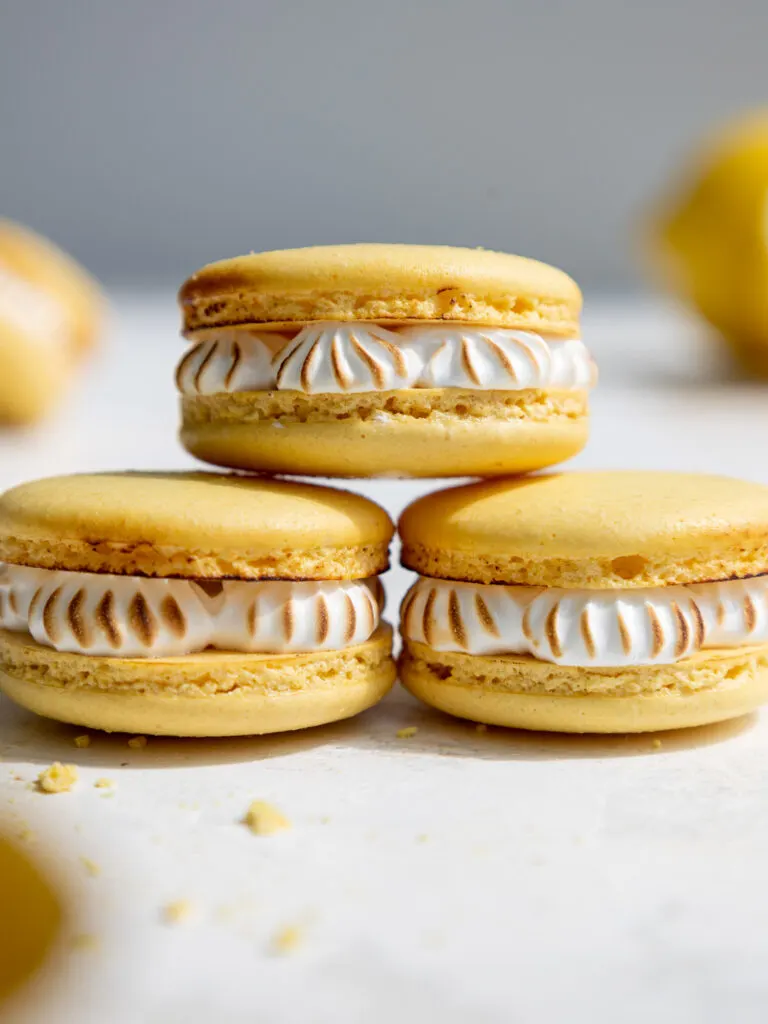
Making These Lemon Meringue Macarons with the French Method
There are a few different ways macarons are made. French macarons are considered easier to make while the Italian and Swiss methods use a few more steps but are more structurally sound.
French macarons also require less equipment. While I love Italian macarons, I like to keep things simple and use the French method for this recipe.
But do keep in mind that we will be filling these with Swiss meringue! While it’s okay to use French meringue to make the shells because they are baked in the oven, we need to heat up the egg whites that will be used in the filling to make them safe to eat.
Equipment You’ll Need to Make These Lemon Meringue Macarons
I’ve made quite a few batches of macarons, and they definitely turn out best when the ingredients are weighed, and the macarons are baked on a silpat mat.
These are the tools I like to use when I make these macarons:
- Kitchen scale
- Stand Mixer or Electric Mixer
- 1 large piping bag
- 2 small piping bags
- Round piping tip (for macaron batter)
- Small french piping tip (for meringue filling)
- Large, flat baking sheets
- Silpat Mats (or parchment paper)
- Scribe or Toothpick
- Saucepan
- Heat-Proof Bowl
- Kitchen Blow Torch
How to Make These Lemon Meringue Macarons: Step-by-Step Process
While the recipe below is quite detailed, I find visual cues to be super helpful!
Below are some photos and a video of the process to help guide you through this recipe.
Or if you’d like to see a long-form video, check out this video about how I make my French macaron recipe.
Step 1: Make the French Meringue
The first step is to make the French meringue!
Whisk the room-temperature egg whites on a medium-low speed until the surface is covered in small bubbles.
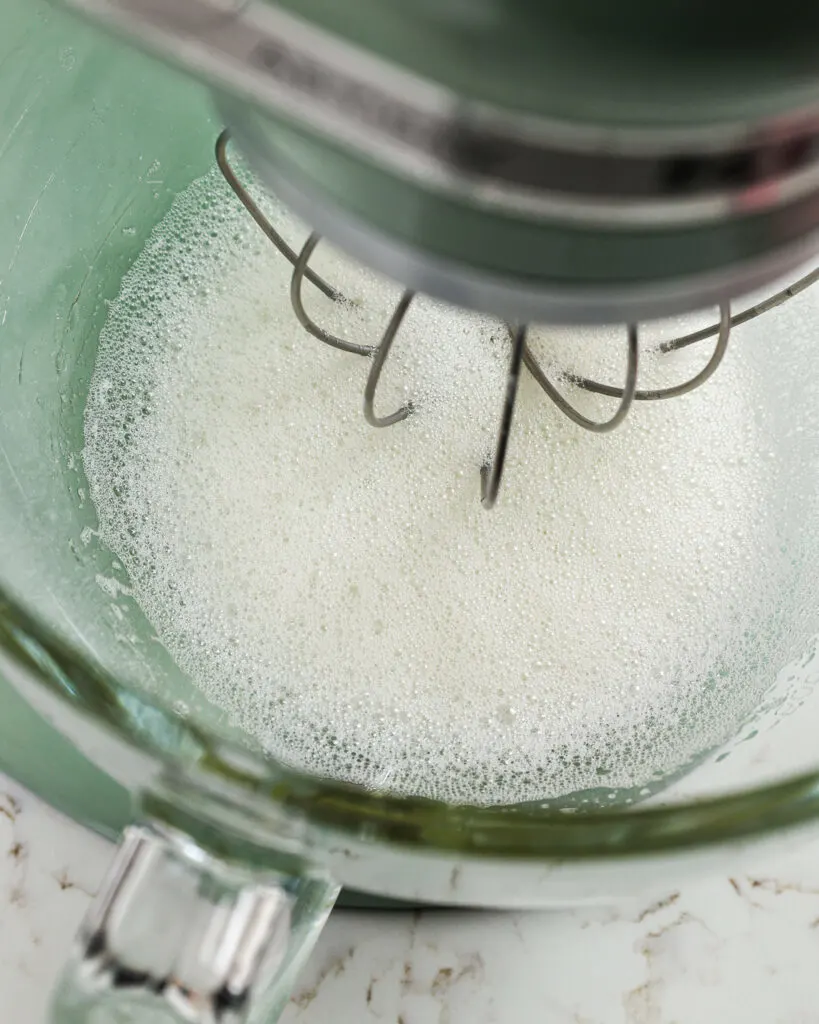
Add in a pinch of cream of tartar and continue to mix until the whisk begins to leave tracks. This is called the soft peak stage.
Gradually add the granulated sugar and mix on a medium speed for 30 seconds. Then increase the mixing speed to a medium-high speed (KitchenAid 6 or 8).
Mix until stiff peaks form like in the photo below. Keep an eye on your mixer to avoid over-mixing the meringue.
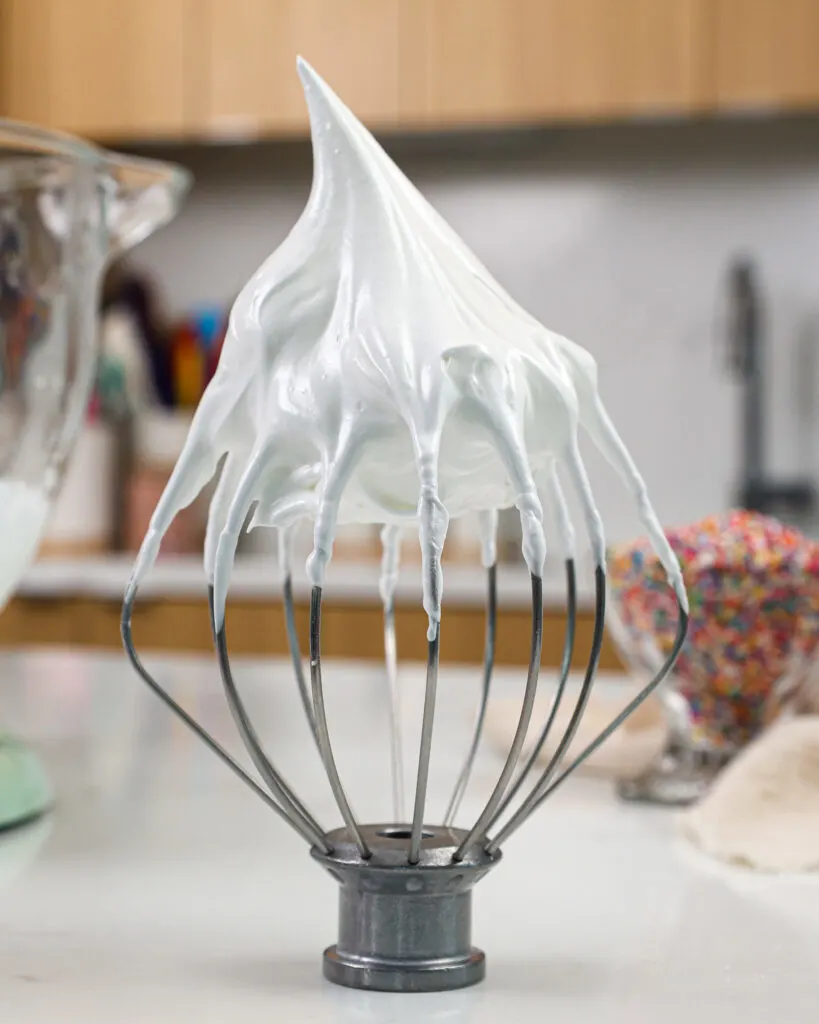
Step 2: Sift and Fold the Dry Ingredients into the Meringue
Sift the superfine almond flour and powdered sugar into the meringue.
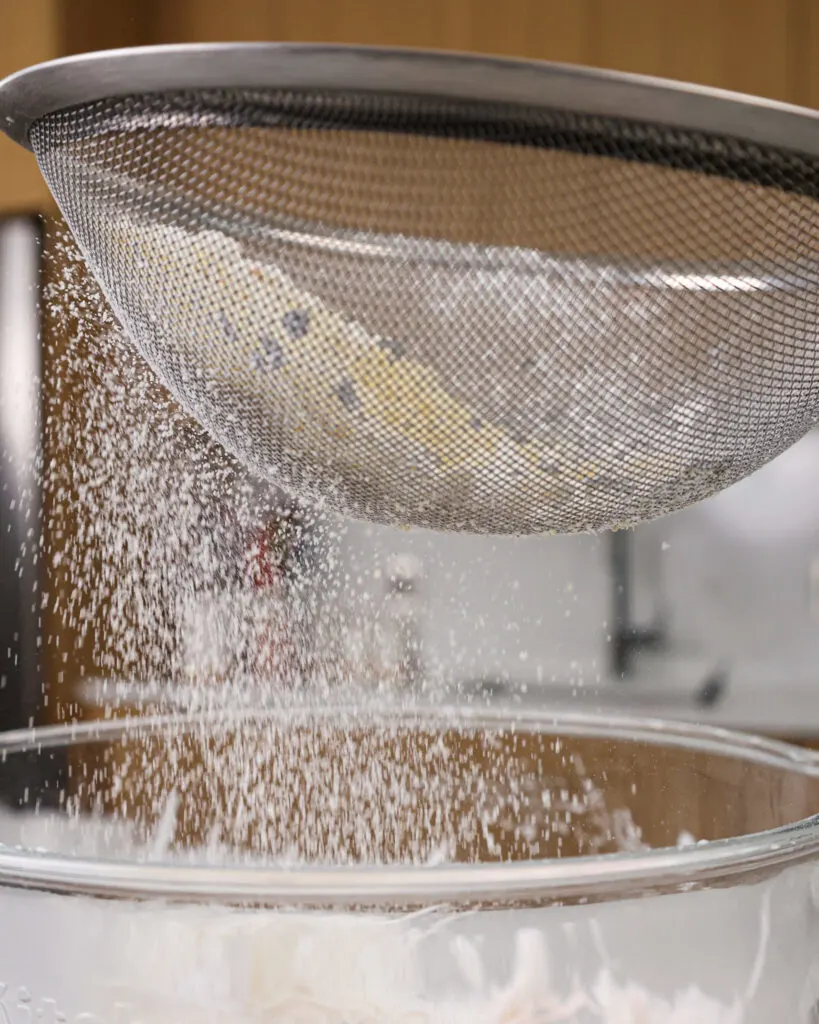
Use a rubber spatula to break up any big clumps and press them through the sieve.
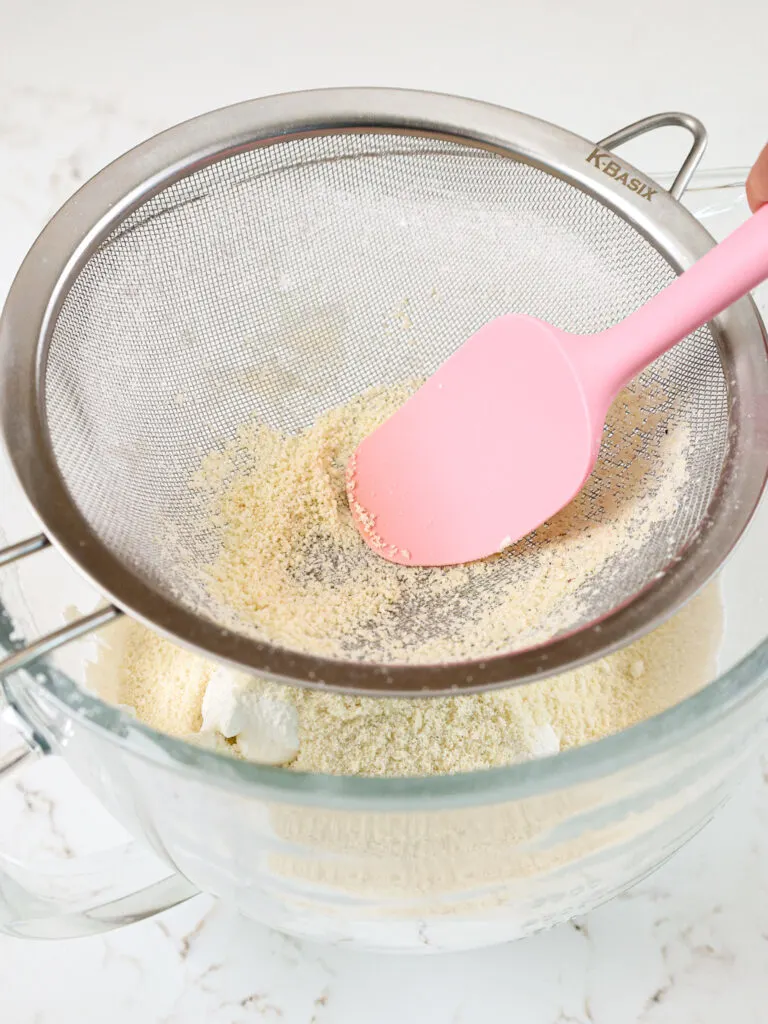
Add in a small squirt of yellow gel food coloring at this point. Then fold the ingredients together with a rubber spatula.
Use a circular motion that sweeps around the edge of the bowl and then pulls through the bottom of the bowl to make sure everything is getting mixed together.
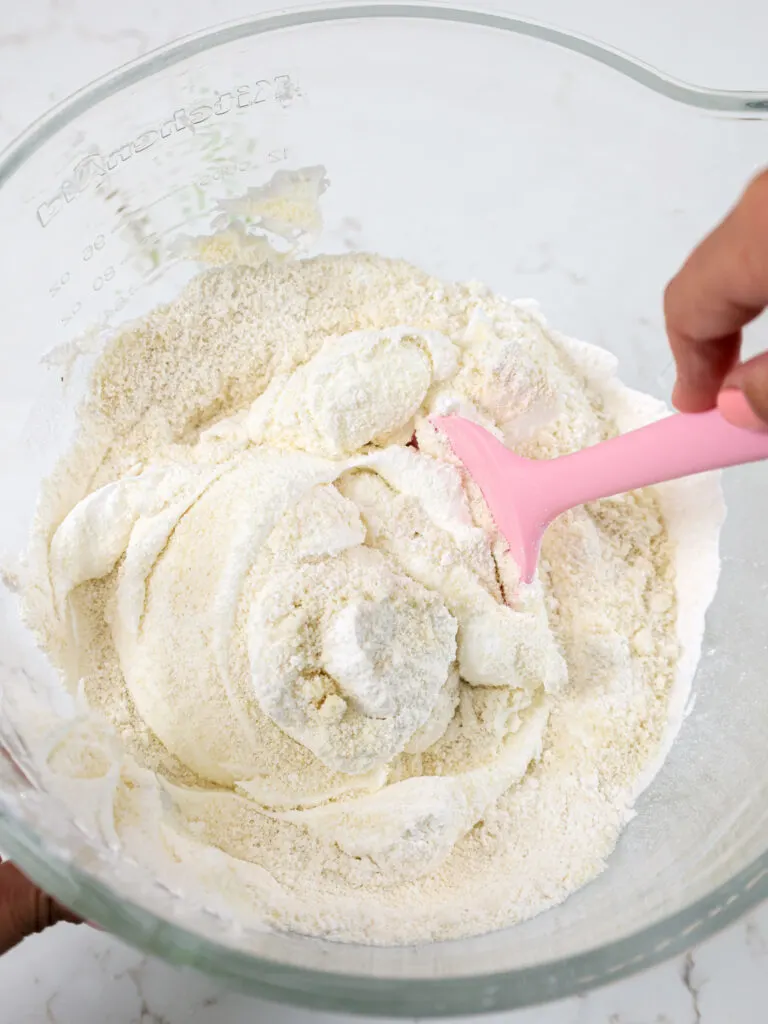
Don’t forget to scrape off the inside of the spatula intermittently. Sometimes meringue can get stuck there and not get mixed in properly.
Fold until a thick ribbon of batter runs off the spatula when it is lifted.
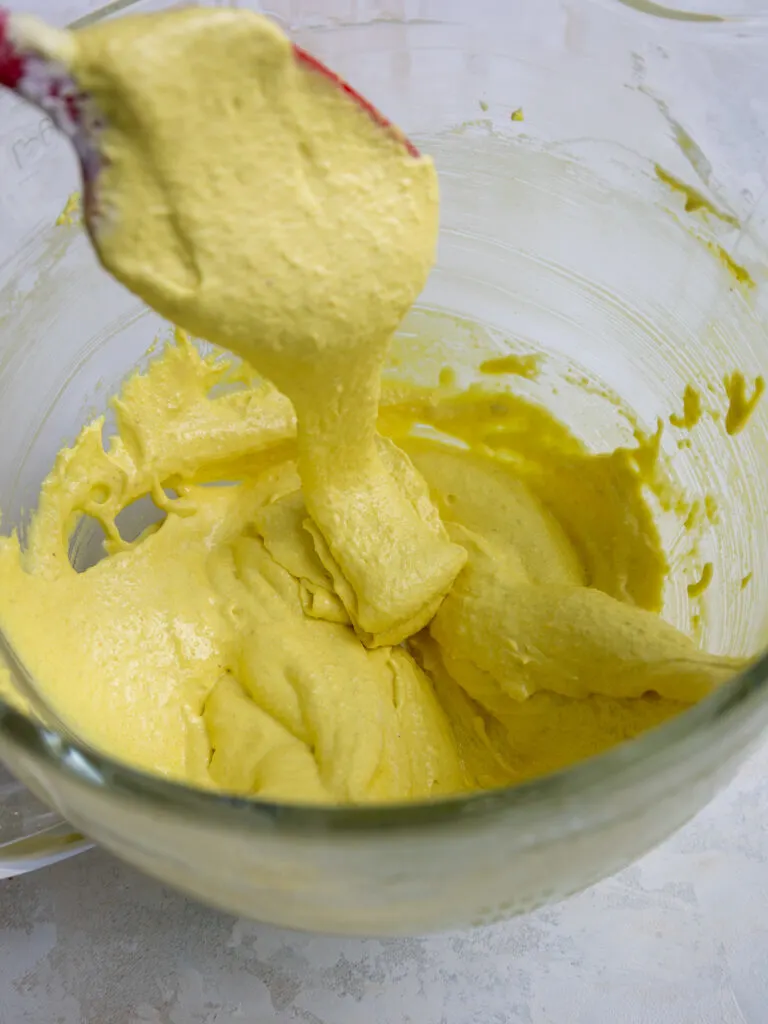
You should be able to draw a couple of figure 8s with the batter running off your spatula in a continuous stream once it is the right consistency.

If the stream of batter breaks before you’re able to do this, you may need to stir it a bit more.
Step 3: Pipe the Macaron Shells
Fill a large piping bag with macaron batter and pipe 1 1/2-inch rounds onto 2 silpat-lined baking sheets. Space them about 1 inch apart.
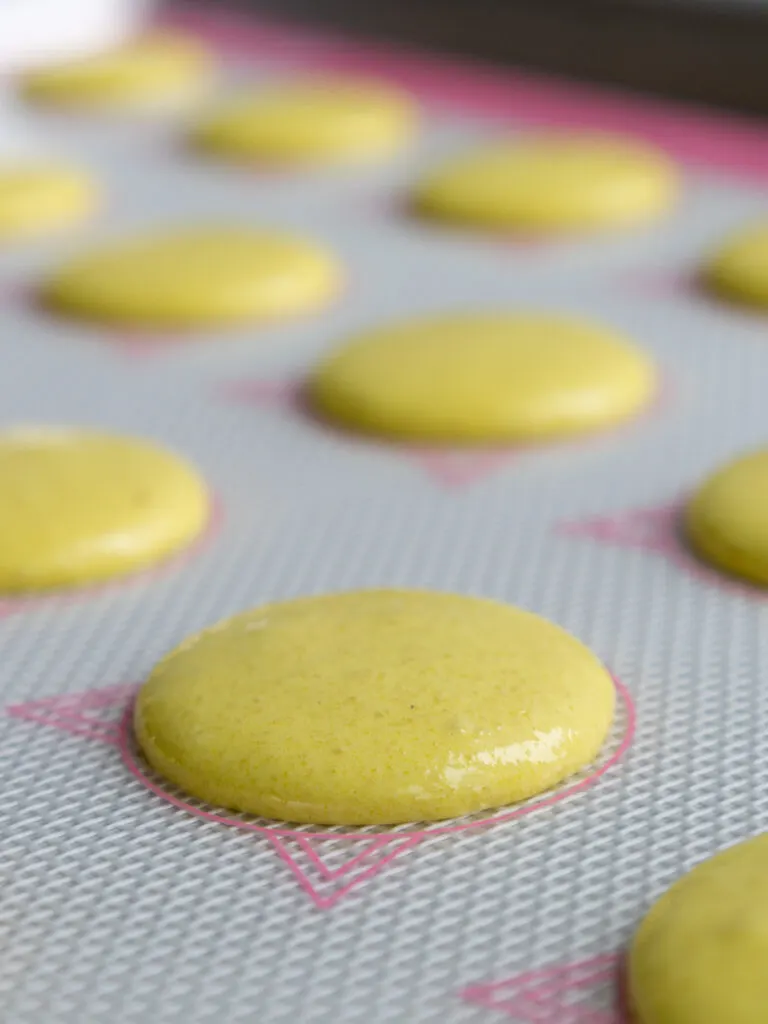
Firmly bang or drop your pans on the counter a few times.
This brings any trapped air bubbles to the surface, which can then be popped with a toothpick or scribe.
Popping these little bubbles can help you avoid hollow or cracked shells.
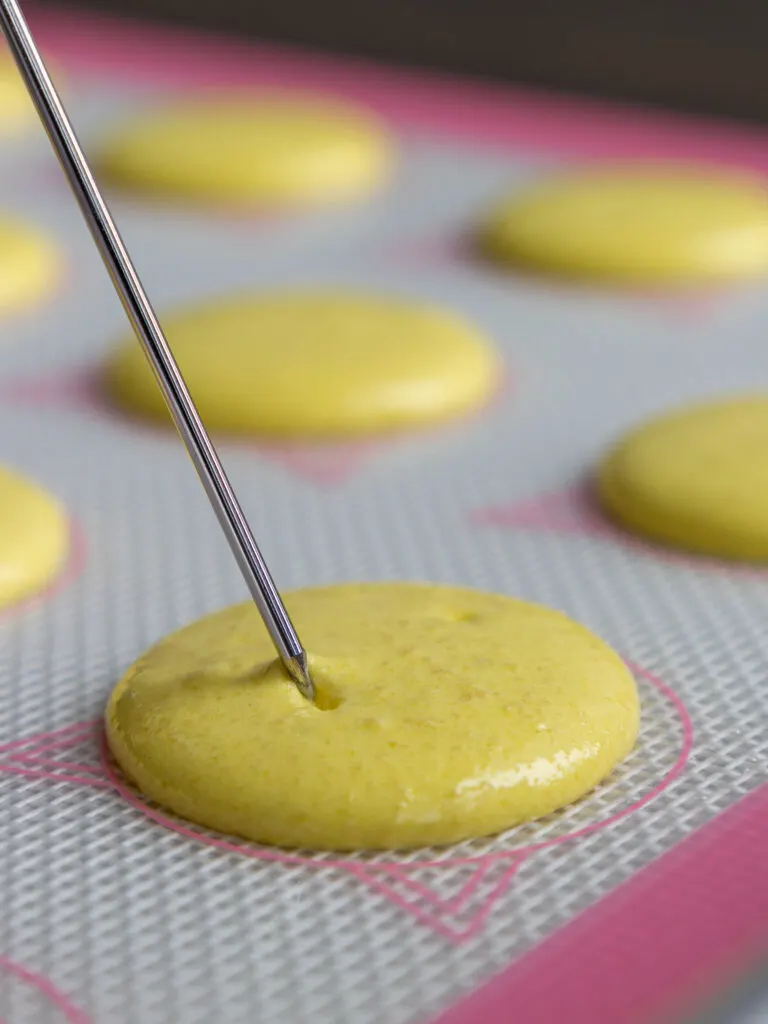
Step 4: Rest the Macaron Shells
Let the macarons rest for about 30 minutes, or until they form a skin. On rainy days this can take up to an hour where I live!
They should be mostly dry to the touch and look matte once they’re ready to be baked.
While the shells rest, preheat your oven.
Step 5: Bake the Macaron Shells
Bake one tray of macarons at a time and place the tray in the middle rack of your oven.
Rotate the pan halfway through to help them bake evenly.
Let the macarons cool fully on the pan, then gently remove them from the Silpat mat.
If they’re properly baked, they should peel off the mat cleanly and have a shiny bottom.

Step 6: Make the Lemon Curd
The lemon curd filling needs a little time to cool and thicken, so I recommend making it next! It can also be made up to 2 weeks in advance.
It takes a little bit of extra time to make from scratch, but it’s totally worth it!
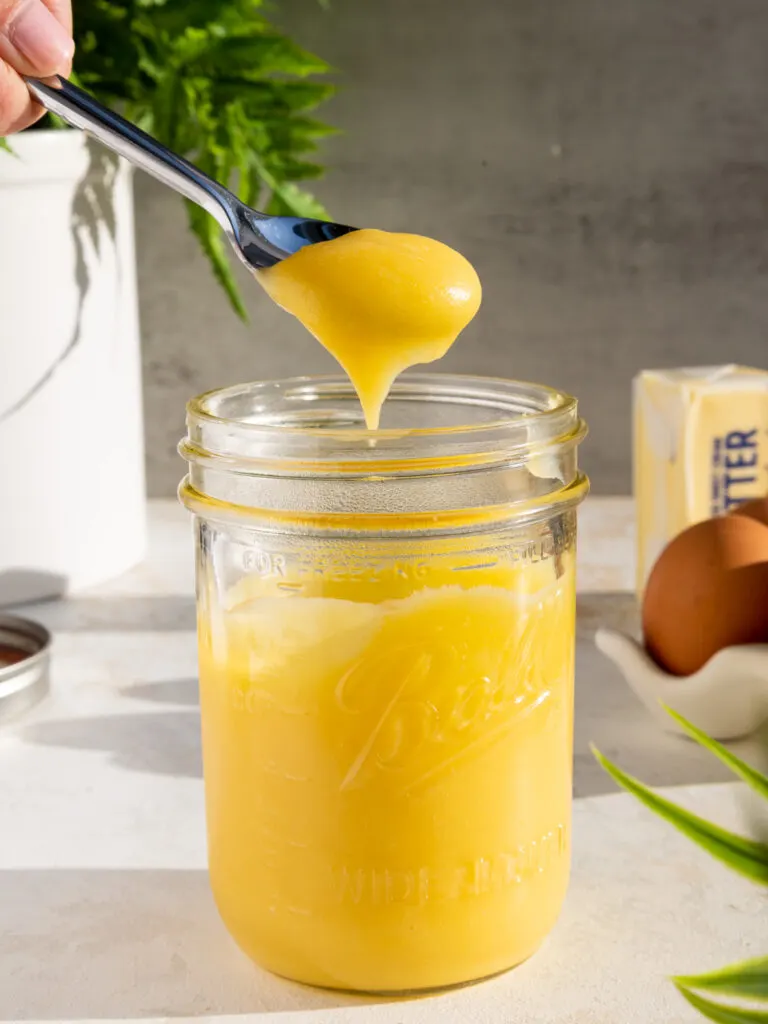
It’s also the perfect way to use up some of the leftover yolks from making the macaron shells.
Step 7: Assemble the Macarons
While the shells and lemon curd cool, make the Swiss meringue. Place it in a small piping bag fitted with a small French piping tip and set aside.
I like to make it right before I fill the macarons so that it keeps its shape.
Pair up the shells, then pipe small dollops of Swiss meringue around one macaron shell.
Fill the center with lemon curd. Gently press a second shell on top of the filling to create a sandwich.
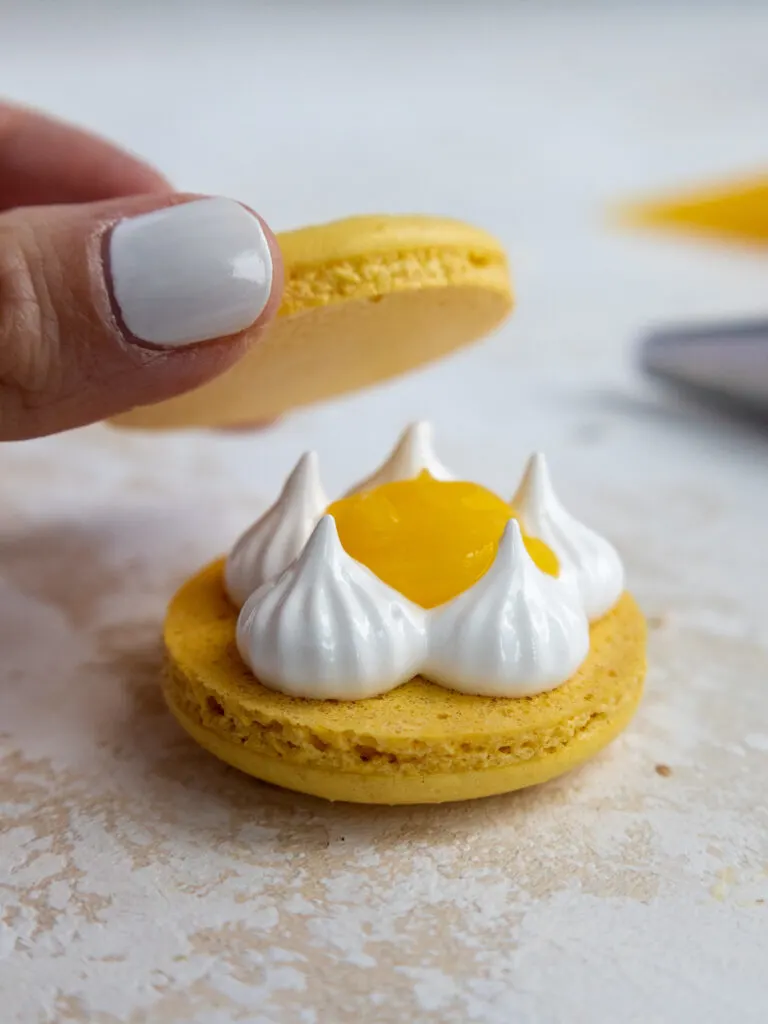
Then carefully use a kitchen blow torch to toast the meringue filling. It’s ok if the sides of the shell get a little bit toasted too.
Place the finished macarons in an airtight container and store them in the fridge to let them mature overnight.

Letting the filled macarons rest overnight softens them (in a good way) and allows the flavor to develop.
When you’re ready to enjoy these macarons, take them out of the fridge and let them sit out for about 15 minutes before eating them to let them come to room temperature.
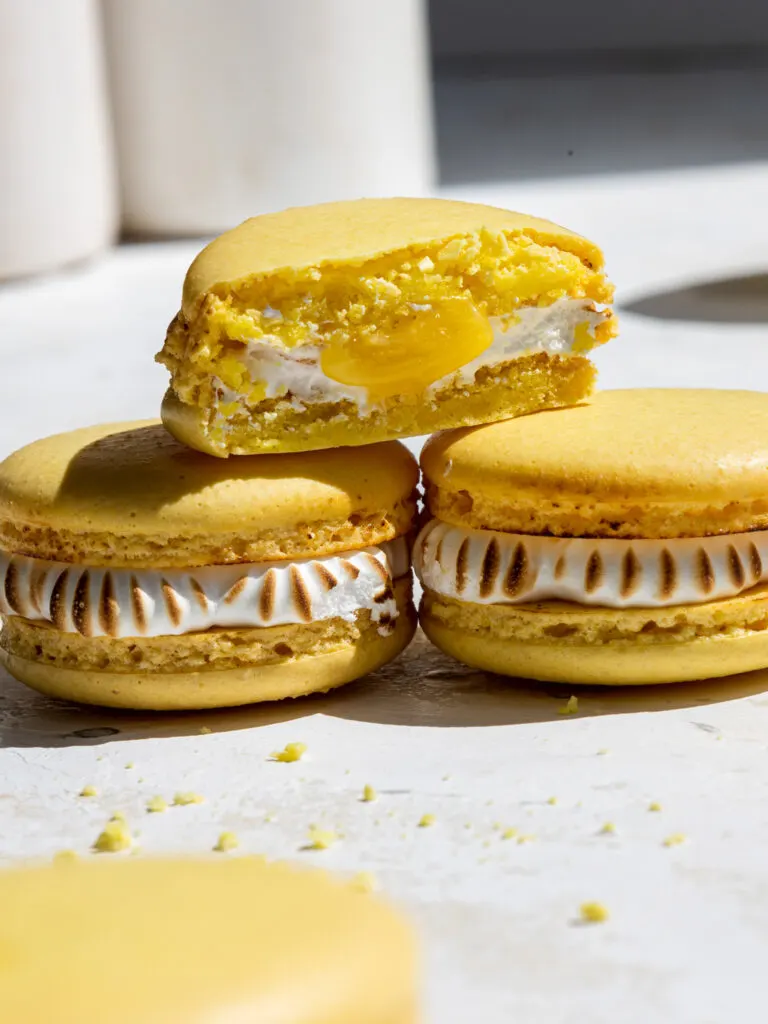
Troubleshooting These Lemon Meringue Macarons
While I’d love to think everyone’s first batch of these macarons will turn out perfectly, I’ve learned that’s not how things always go.
Macarons are incredibly temperamental, and it might take a few tries to get them just right. If you run into any issues, check out my macaron troubleshooting guide!
Choosing the Right Filling for These Macarons
While we put tons of energy into the shell of a macaron, almost all the flavor in a macaron comes from its filling.
The shell gives macarons an incredible texture, but the filling is what determines its flavor.
I think this combination of tart, sweet lemon curd, and toasted meringue makes these taste just like lemon meringue pie!
If you like a sweeter filling, I recommend making a quarter batch of my hybrid buttercream or my American buttercream instead of the meringue.
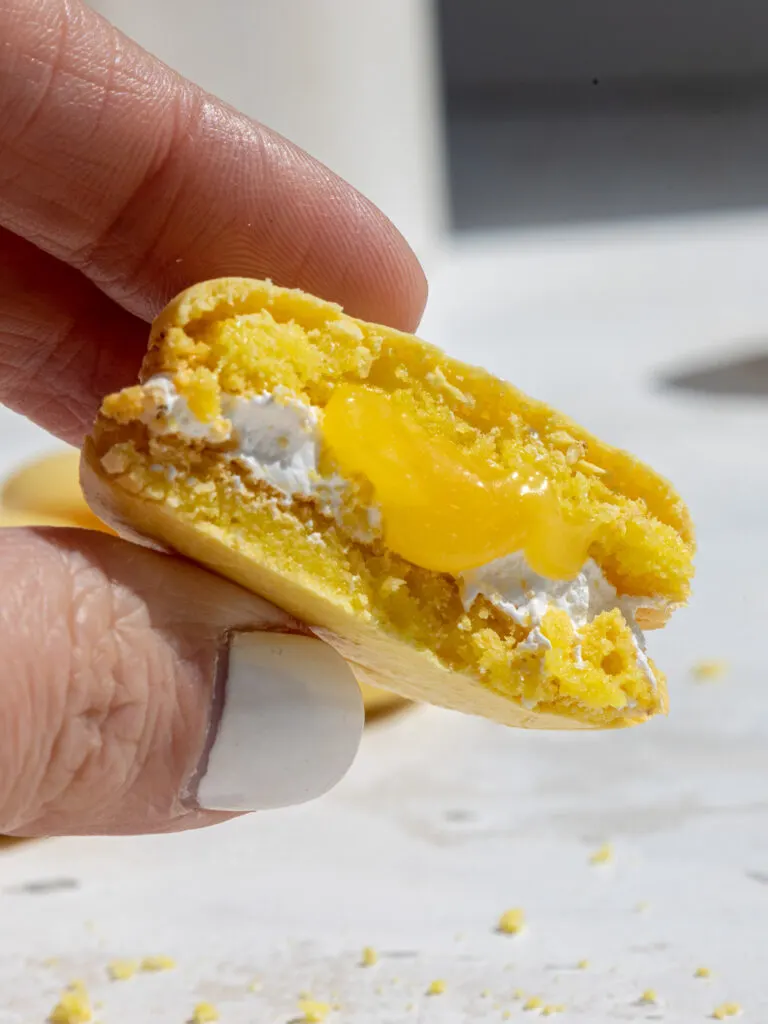
Recipe Yield
This recipe makes about 48 large macaron shells, which can be used to make 24 macarons.
You can double or halve this recipe as needed.
The yield and bake time will vary based on the size of the macarons you pipe. I piped these shells with a diameter of 1 1/2 inches.
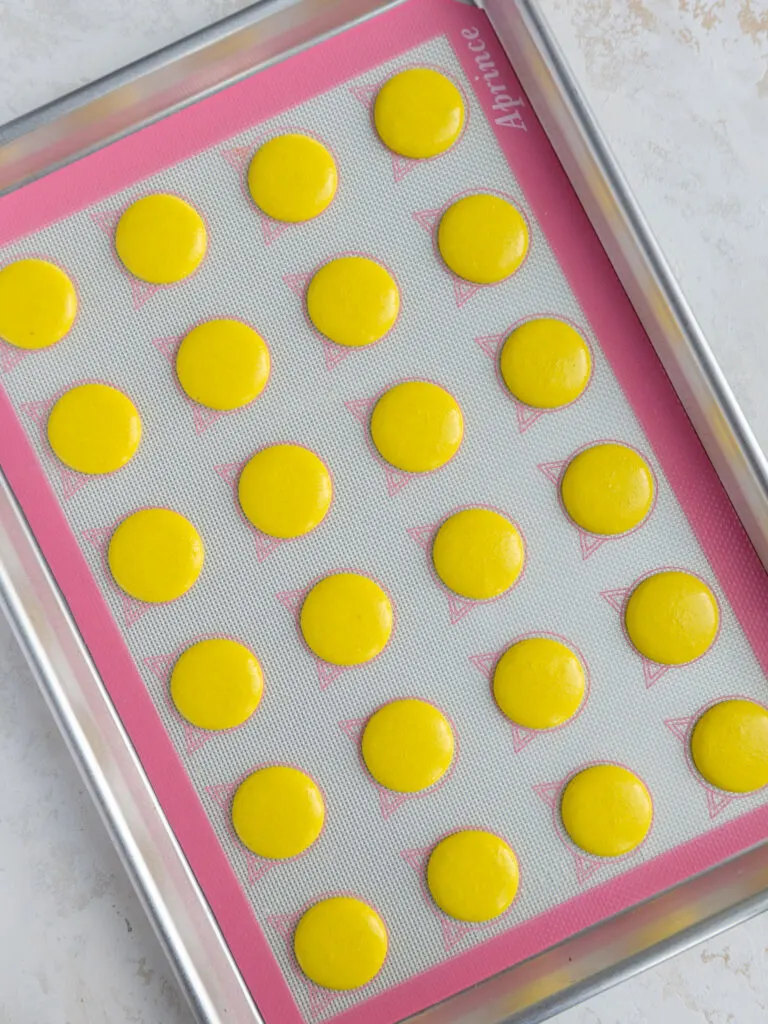
Tips for Making the Best Lemon Meringue Macarons
- Wipe your mixing bowl, whisk, and baking mats with lemon juice or vinegar to remove any traces of grease before making the meringue. It will help your egg whites whip up better!
- Separate your eggs and age them if possible. Do not use egg whites from a carton.
- Measure the ingredients in grams with a kitchen scale. You really need to be precise with this recipe.
- Use a macaron mat or print out a template to help you pipe consistently sized macarons.
- Let the baked and filled macarons mature. This softens them (in a good way) and allows the flavors to develop.
- If your macarons don’t turn out, check out my macaron troubleshooting guide.
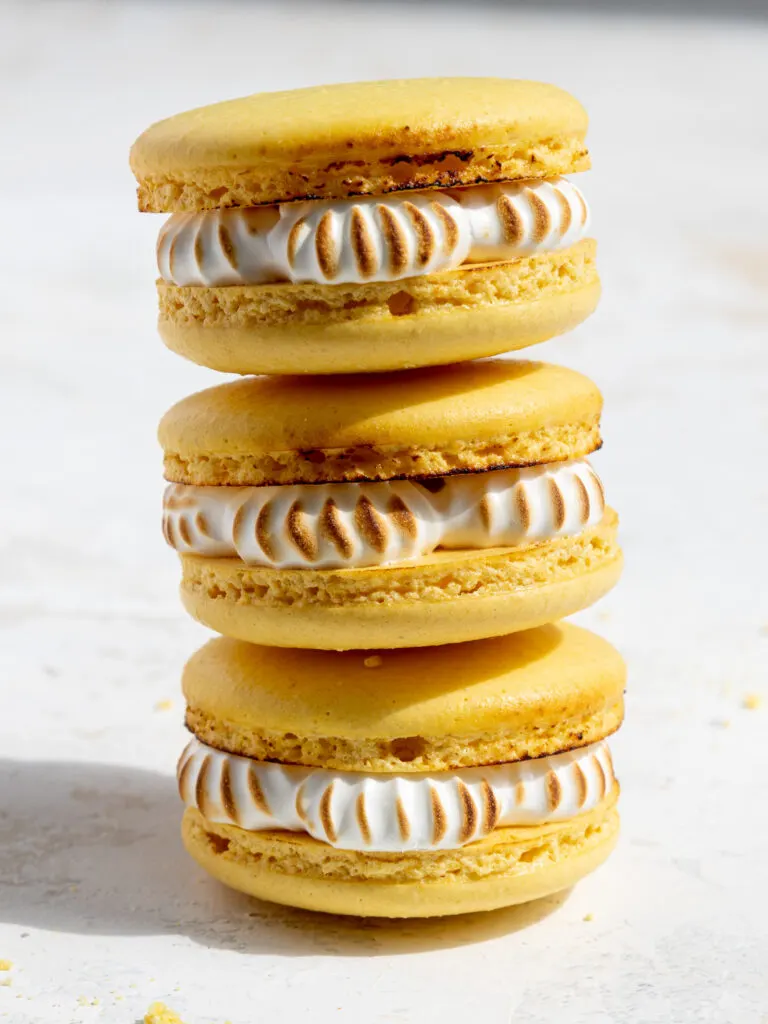
Making These Lemon Meringue Macarons in Advance & Storage Tips
I don’t recommend making the Swiss meringue filling in advance. It will lose its shape as it sits.
However, the lemon curd filling can also be made ahead of time, or you can save any leftover filling! Store in an airtight container in the fridge for up to 2 weeks.
These macarons need to mature overnight in the fridge before being eaten. This gives them time to develop the best texture and taste.
Filled macarons can be refrigerated for up to 5 days or frozen for up to a month in an airtight container.
Unfilled macaron shells can be frozen for up to 2 months in an airtight container.

Let Me Know What You Think!
If you try this recipe for lemon meringue macarons, I’d love to hear what you think! Please leave a rating and comment below.
Tag me @chelsweets and use #chelsweets on social media so that I can see your amazing creations!
Other Recipes You Might Like:
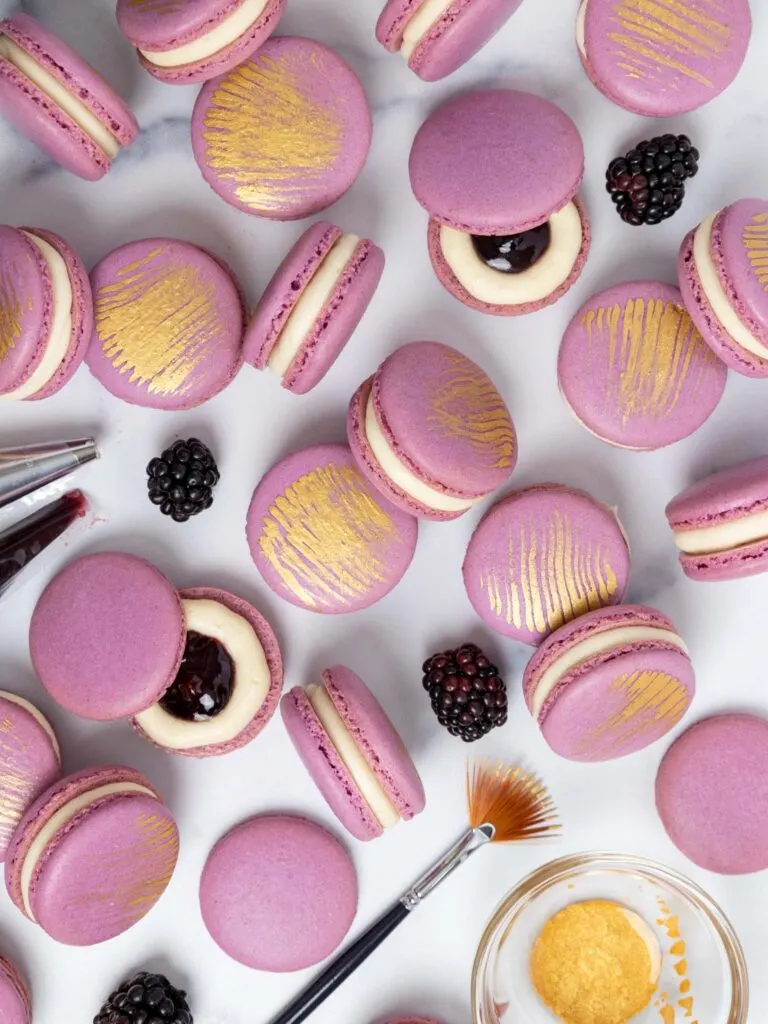
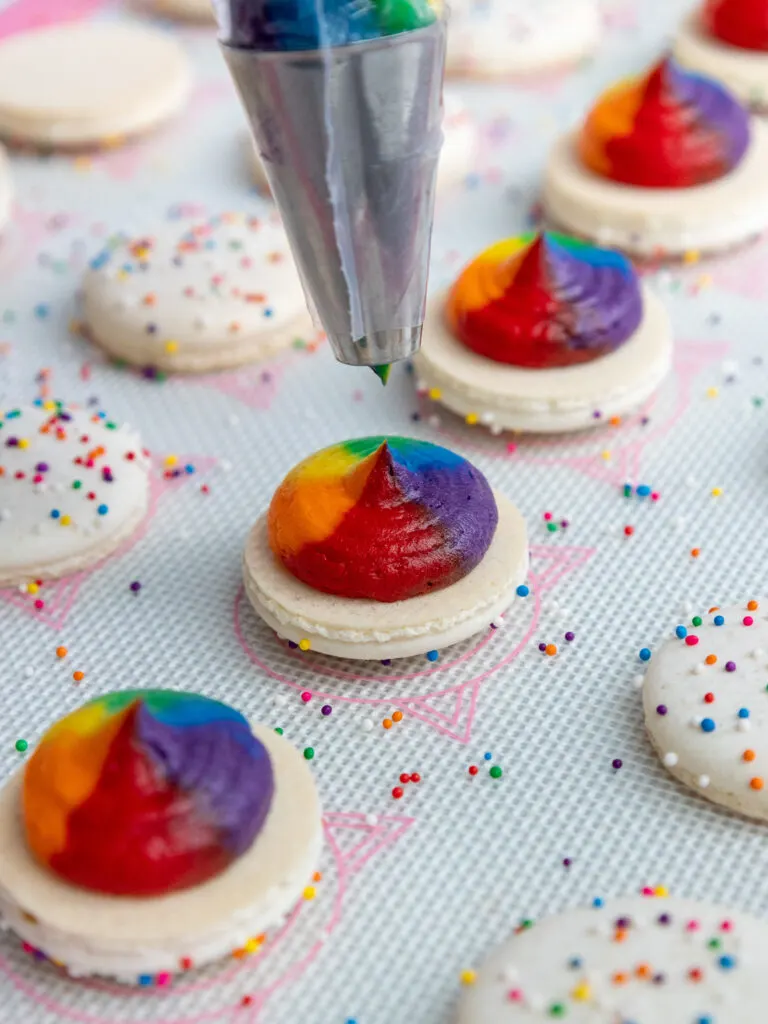
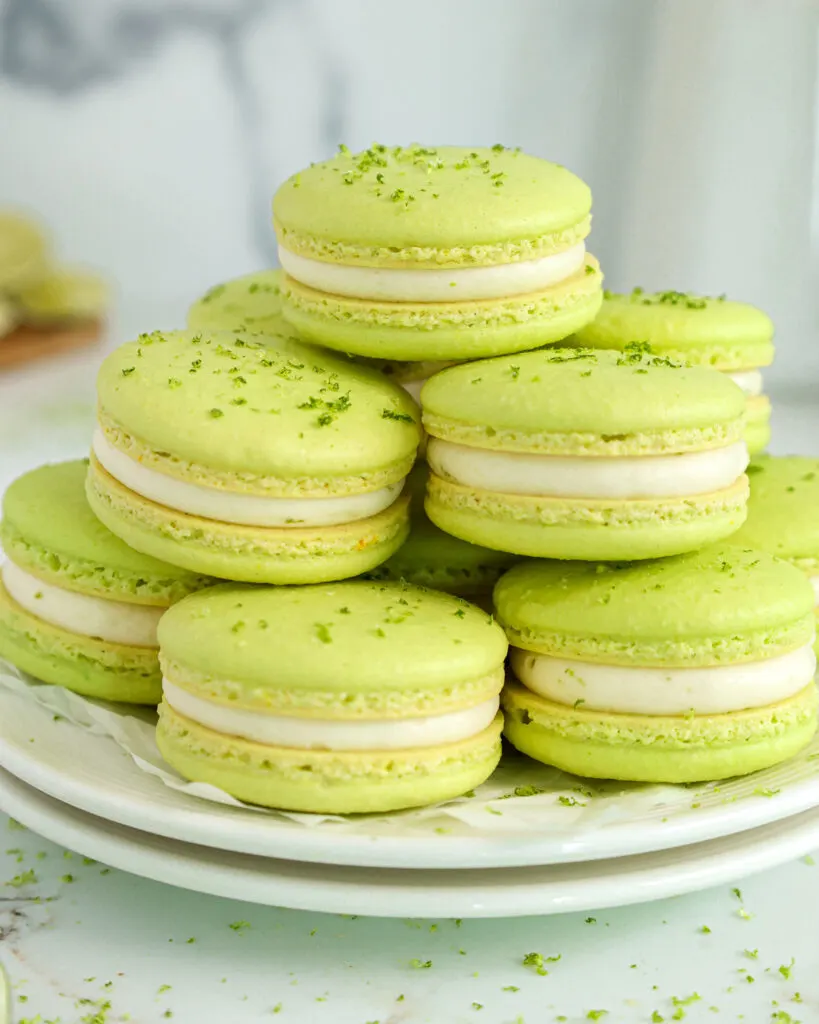
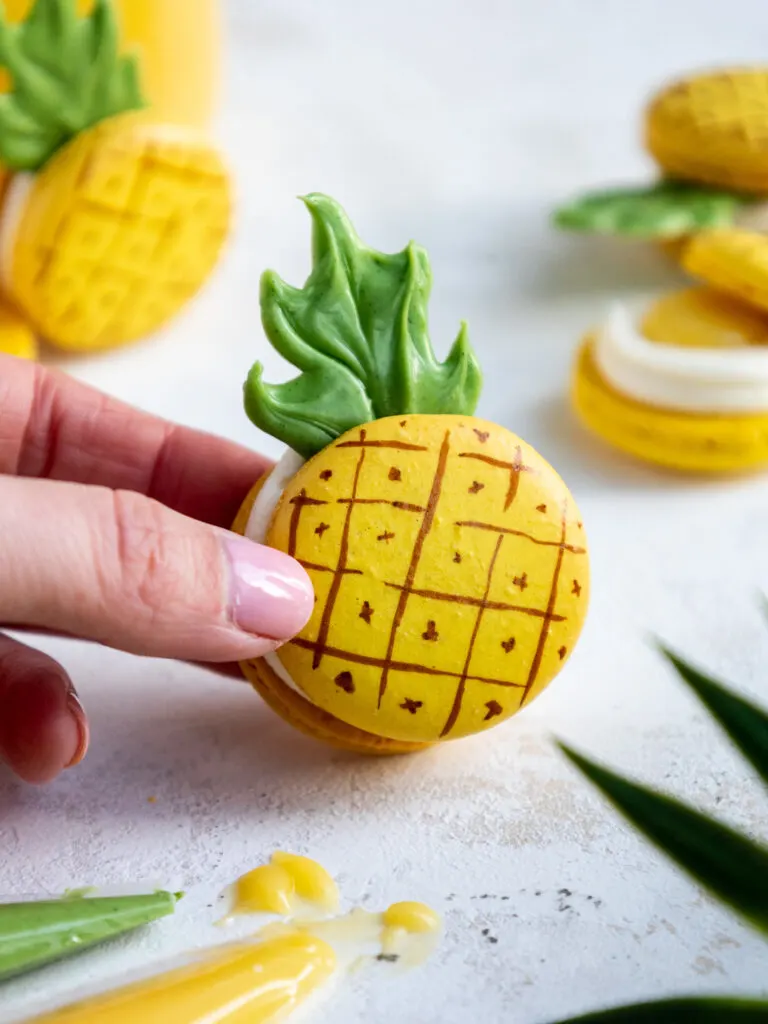
Lemon Meringue Macarons

These lemon meringue macarons are perfect for summer! They're filled with tart lemon curd and sweet, toasted meringue.
Ingredients
Macarons Shells
- 110g aged egg whites; SAVE 2 OF THE EGG YOLKS TO MAKE THE LEMON CURD BELOW
- 1/4 tsp cream of tartar - optional
- 110g granulated sugar (1/2 cup + 2 tsp)
- 140g superfine almond flour - blanched (1 1/2 cups)
- 125g powdered sugar (1 cup)
- yellow gel food coloring
Lemon Curd
- 100g granulated sugar (1/2 cup)
- 5g lemon zest - zest of 1 large lemon (1 tbsp)
- 40g large egg yolks (2 egg yolks)
- 60g lemon juice - juice of large lemon (1/4 cup)
- 56g butter unsalted, cold, and cut into Tbsp-sized pieces (1/4 cup)
Swiss Meringue
- 70g egg whites (2 large egg whites)
- 100g granulated sugar (1/2 cup)
- 10g vanilla extract (2 tsp)
Equipment
- Kitchen scale
- Stand Mixer or Electric Mixer
- Large, flat baking sheets
- Silpat Mats (or parchment paper)
- 1 Large Piping Bag (18-inch)
- Round Piping Tip - Ateco 805
- 2 Small Piping Bags (12-inch)
- Small French Piping Tip
- Kitchen Blow Torch
Instructions
Yellow Macaron Shells
- Line two large baking sheets with parchment paper or silicon mats. Set aside.
- Pour 110g of aged egg whites into the bowl of a stand mixer with a whisk and mix on medium speed until the surface of the egg whites is covered in small bubbles. Add 1/4 tsp cream of tartar and continue to mix until it reaches the soft peak stage and leaves visible tracks.
- Gradually mix 110g of granulated sugar into the egg whites over a few minutes while mixing on a medium-low speed. Increase the mixing speed to a medium-high speed (6 on a KitchenAid). Keep mixing until stiff, glossy peaks form.
- Sift 140g of superfine almond flour and 125g of powdered sugar into the meringue. Use a rubber spatula to break up any big clumps and press them through the sieve.
- Add in a small squirt of yellow gel food coloring to give the shells a light-yellow color.
- Fold the ingredients together with a rubber spatula. Use a circular motion that sweeps around the edge of the bowl and then pulls through the bottom of the bowl to make sure everything is getting mixed together. Don't forget to scrape off the inside of the spatula intermittently. Sometimes meringue can get stuck there and not get mixed in properly.
- Fold the batter until a thick ribbon of batter runs off the spatula when it's lifted. You should be able to draw a couple of figure 8s with the batter running off your spatula in a continuous stream when it's the right consistency. If the stream of batter breaks before you're able to do this, you may need to stir it a bit more.
- Pour the batter into a large piping bag fit with a medium-sized round piping tip and pipe 1 1/2-inch rounds on the prepared baking sheets. Space them about 1 inch apart.
- Bang the pans firmly on the counter a few times to release air bubbles, then pop any remaining air bubbles that come to the surface with a toothpick.
- Let the macarons rest for 30 minutes, or until they develop a skin. The macarons should look matte once the skin has formed. While the macarons rest, preheat the oven to 320 F / 160 C.
- Bake one tray of macarons at a time on the middle rack of your oven for 18-21 minutes and rotate the pan halfway through to help the macarons bake evenly. Bake time can vary based on the size of your shells, so if you pipe them smaller than 1 1/2 inches, they may be done a few minutes earlier.
- Remove the macaron shells from the oven and let them cool fully on the pan (about 30 minutes), then gently peel them off the Silpat mat. If they're properly baked, they should peel off the mat cleanly and have a shiny bottom.
Lemon Curd
- Make the lemon curd next! It needs time to cool and thicken. If you don't want to make lemon curd, you can use store-bought lemon curd.
- Add 100g of sugar into a small saucepan. Zest 1 large lemon into the saucepan and massage the zest into the sugar with your fingertips. This helps release the oil in the zest and gives this curd a bright, citrusy flavor.
- Add in 2 egg yolks and whisk the mixture together until it becomes lighter in color. Then mix in 60g of lemon juice.
- Heat on medium-low, stirring constantly with a wire whisk until the mixture thickens and just starts to bubble.
- Remove the pan from heat, then add 56g cold butter that's been cut into smaller pieces. Mix until the butter is fully melted, and the ingredients are combined.
- Pour the lemon curd through a fine mesh strainer into a separate bowl to remove any bits of cooked egg, zest, or lemon seeds. This gives it a perfectly smooth texture! Set aside to cool. If you make the curd in advance, cover it flush with plastic wrap to prevent it from forming a skin and store it in the fridge for up to a month.
Swiss Meringue
- While the macaron shells bake and cool, make the Swiss meringue. I like to make it right before I fill the macarons so that it keeps its shape.
- In a medium-sized pot, add about 1 inch of water and bring to a simmer.
- Add 70g of egg whites and 100g of granulated sugar into a large metal bowl.
- Place the bowl on top of the pot filled with simmering water. The bowl should create a seal over the pot. Make sure the water isn’t actually touching the bottom of the bowl, or it can cook the egg whites.
- Whisk the mixture constantly for about 1 1/2 minutes, or until it reaches 160°F / 71°C. You can test the mixture to see if it’s ready by rubbing a tiny bit between your fingertips. The sugar should be fully dissolved, and it should feel super smooth and hot to the touch.
- Lift the bowl away from the pot and dry the bottom with a towel. Pour the mixture into the bowl of a stand mixer and add 2 tsp of vanilla extract. Beat on a medium-high speed with a whisk attachment for about 10 minutes, or until you have stiff, glossy peaks.
- Place the meringue in a small piping bag with a small French piping tip or snip an opening that is about 1 cm wide. Seal the top of the bag with a rubber band or clip.
Assembling These Lemon Meringue Macarons
- Pair up the shells, then pipe small dollops of Swiss meringue around one macaron shell. Fill the center with lemon curd.
- Gently press a second shell on top of the filling to create a sandwich, then carefully use a kitchen blow torch to toast the meringue filling. It's ok if the sides of the shell get a little bit toasted too.
- Place the finished macarons in an airtight container and chill in the fridge overnight. When you're ready to enjoy these macarons, take them out of the fridge and let them sit out for about 15 minutes before eating them to let them come to room temperature.
Notes
Recipe Yield
This recipe makes about 48 macaron shells, which can be used to make 24 macarons. You can double or half this recipe if needed.
The yield and bake time can vary based on how large you pipe your shells. I piped these shells with a diameter of 1 1/2 inches, so they're about the size of a standard macaron.
Tips for Making the Best Lemon Meringue Macarons
- Measure the ingredients in grams with a kitchen scale! You really need to be precise with this recipe. Your macarons will turn out best if the ingredients are weighed.
- Separate your own eggs and age them if possible! Do not use egg whites from a carton.
- Carefully read through the directions before making these macarons. There are quite a few steps and it's good to know your game plan before you start!
- Use a macaron mat or print out a template to help you pipe consistently sized macarons.
- FIRMLY bang the pans on your counter after piping your macarons. This helps release any air bubbles that may be trapped and prevent cracked or hollow shells.
- Rest the macarons for 30 minutes before they're baked to allow them to develop a skin.
- Let the filled macarons mature in the fridge overnight! This softens them (in a good way) and allows the flavors to develop.
- If your macarons don't turn out, please check out my macaron troubleshooting guide for help!
Making These Lemon Meringue Macarons in Advance & Storage Tips
I don't recommend making the Swiss meringue filling in advance. It will lose its shape as it sits.
However, the lemon curd filling can also be made ahead of time, or you can save any leftover filling! Store in an airtight container in the fridge for up to 2 weeks.
These macarons need to mature overnight in the fridge before being eaten. This gives them time to develop the best texture and taste.
Filled macarons can be refrigerated for up to 5 days or frozen for up to a month in an airtight container.
Unfilled macaron shells can be frozen for up to 2 months in an airtight container.
Nutrition Information
Yield
24Serving Size
1Amount Per Serving Calories 168Total Fat 7gSaturated Fat 3gTrans Fat 0gUnsaturated Fat 4gCholesterol 48mgSodium 42mgCarbohydrates 26gFiber 1gSugar 24gProtein 3g

Astrid
Thursday 14th of September 2023
Hi Chelsey A few years ago I made very often macarons. Now I have discovered your recipe and would like to try it. But I have a question about the oven. You heat up to 160 ° C (320 F). With "hot air" (fan) or top and bottom heat? I always struggled a bit with baking back then, would love to try it your way. Greetings from Switzerland Astrid
Chelsweets
Thursday 14th of September 2023
Hi Astrid,
Great question! I don't usually use the fan setting in my oven when I'm making macarons.
Getting the temperature right can definitely be challenging, especially because even oven bakes a bit differently. Hope that helps, and that your next batch of macarons is delicious :)